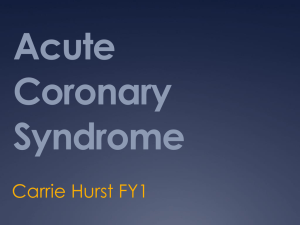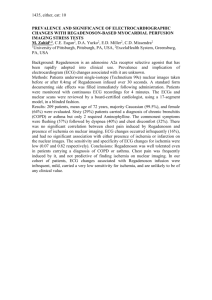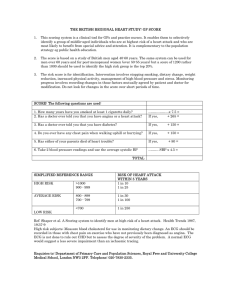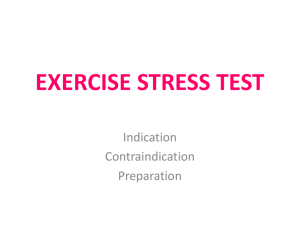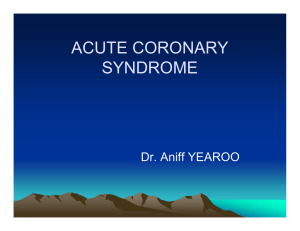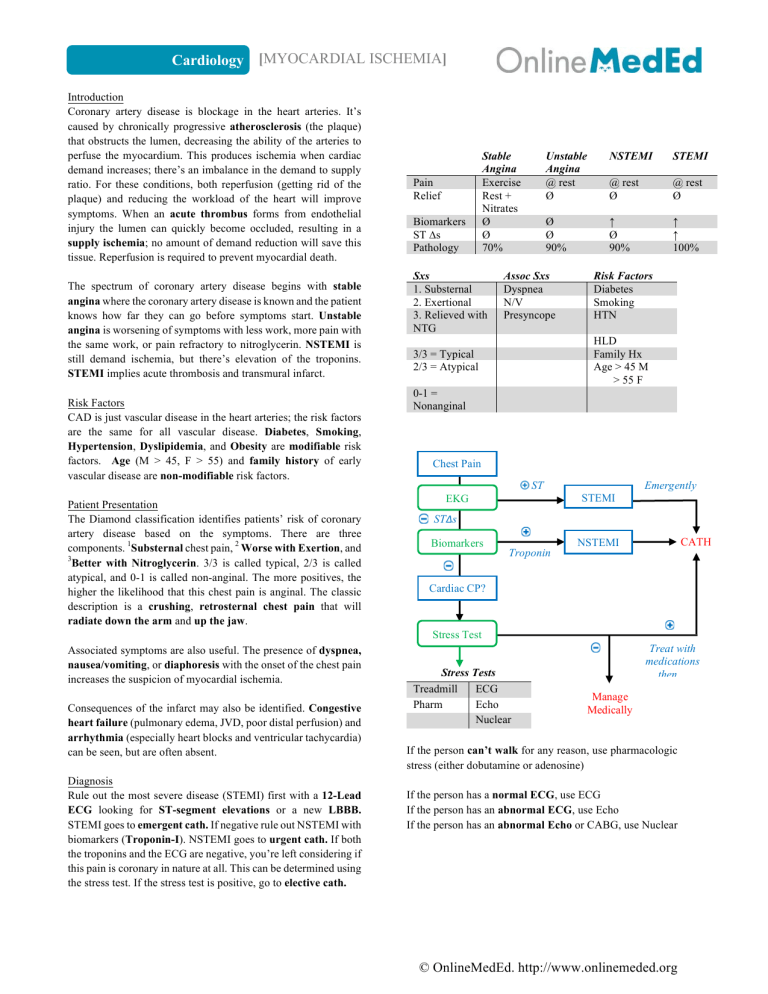
Cardiology [MYOCARDIAL ISCHEMIA] Introduction Coronary artery disease is blockage in the heart arteries. It’s caused by chronically progressive atherosclerosis (the plaque) that obstructs the lumen, decreasing the ability of the arteries to perfuse the myocardium. This produces ischemia when cardiac demand increases; there’s an imbalance in the demand to supply ratio. For these conditions, both reperfusion (getting rid of the plaque) and reducing the workload of the heart will improve symptoms. When an acute thrombus forms from endothelial injury the lumen can quickly become occluded, resulting in a supply ischemia; no amount of demand reduction will save this tissue. Reperfusion is required to prevent myocardial death. The spectrum of coronary artery disease begins with stable angina where the coronary artery disease is known and the patient knows how far they can go before symptoms start. Unstable angina is worsening of symptoms with less work, more pain with the same work, or pain refractory to nitroglycerin. NSTEMI is still demand ischemia, but there’s elevation of the troponins. STEMI implies acute thrombosis and transmural infarct. Risk Factors CAD is just vascular disease in the heart arteries; the risk factors are the same for all vascular disease. Diabetes, Smoking, Hypertension, Dyslipidemia, and Obesity are modifiable risk factors. Age (M > 45, F > 55) and family history of early vascular disease are non-modifiable risk factors. Patient Presentation The Diamond classification identifies patients’ risk of coronary artery disease based on the symptoms. There are three components. 1Substernal chest pain, 2 Worse with Exertion, and 3 Better with Nitroglycerin. 3/3 is called typical, 2/3 is called atypical, and 0-1 is called non-anginal. The more positives, the higher the likelihood that this chest pain is anginal. The classic description is a crushing, retrosternal chest pain that will radiate down the arm and up the jaw. Pain Relief Biomarkers ST ∆s Pathology Stable Angina Exercise Rest + Nitrates Ø Ø 70% Sxs 1. Substernal 2. Exertional 3. Relieved with NTG Unstable Angina @ rest Ø NSTEMI STEMI @ rest Ø @ rest Ø Ø Ø 90% ↑ Ø 90% ↑ ↑ 100% Assoc Sxs Dyspnea N/V Presyncope Risk Factors Diabetes Smoking HTN HLD Family Hx Age > 45 M > 55 F 3/3 = Typical 2/3 = Atypical 0-1 = Nonanginal Chest Pain ST ∆s EKG Emergently STEMI ST∆s Biomarkers CATH NSTEMI Troponin Cardiac CP? Stress Test Associated symptoms are also useful. The presence of dyspnea, nausea/vomiting, or diaphoresis with the onset of the chest pain increases the suspicion of myocardial ischemia. Consequences of the infarct may also be identified. Congestive heart failure (pulmonary edema, JVD, poor distal perfusion) and arrhythmia (especially heart blocks and ventricular tachycardia) can be seen, but are often absent. Diagnosis Rule out the most severe disease (STEMI) first with a 12-Lead ECG looking for ST-segment elevations or a new LBBB. STEMI goes to emergent cath. If negative rule out NSTEMI with biomarkers (Troponin-I). NSTEMI goes to urgent cath. If both the troponins and the ECG are negative, you’re left considering if this pain is coronary in nature at all. This can be determined using the stress test. If the stress test is positive, go to elective cath. Stress Tests Treadmill ECG Pharm Echo Nuclear Treat with medications then… Manage Medically If the person can’t walk for any reason, use pharmacologic stress (either dobutamine or adenosine) If the person has a normal ECG, use ECG If the person has an abnormal ECG, use Echo If the person has an abnormal Echo or CABG, use Nuclear © OnlineMedEd. http://www.onlinemeded.org Cardiology [MYOCARDIAL ISCHEMIA] 1. 2. Diagnostic Modalities The stress test Regardless of the mechanism used, it’s looking for the same thing: evidence of ischemia under stress. The goal is to get the patient to target heart rate (85% of their maximum) and have them sustain it. The test is positive if there’s chest pain during stress or the imaging modality is positive. For ECG test, look for ST segment changes (T wave inversion or ST segment elevations). For the Echo, look for dyskinesia (also called akinesis) that’s present on stress but absent at rest (this is at-risk but not dead tissue). Nuclear stress tests demonstrate perfusion with Thallium. The reversibility (normal perfusion at rest, compromised with stress) identifies salvageable tissue. Whenever the stress test is positive, the next step is catheterization. Catheterization This is the best test for the diagnosis of coronary artery disease. It assesses the severity of stenosis AND helps rule out Prinzmetal’s angina (clean coronary arteries producing ischemia as a product of vasospasm - treat with CCB). Can’t Exercise: Peripheral Vascular Disease, Claudication, vasculitis, diabetic ulcers, SOB at rest, etc. Can’t Read ECG: Any BBB or old infarct “Dead Things Don’t Move” Stress Normal Wall Motion Akinesis Akinesis No Dz Ischemia Infarct Normal Wall Motion Normal Wall Motion Akinesis Acute Treatment Patients presenting with angina need Aspirin, first and foremost. Nitrates can be given to alleviate pain, but must be avoided in right-sided infarcts (II, III, AvF). Beta-blockers reduce myocardial work and prevent ventricular arrhythmias (the thing that kills patients in the first 24 hours). ACE-inhibitors have long term benefits. Statins are the mainstay of therapy for cholesterol. If it’s certain this is Acute Coronary Syndrome, therapeutic heparin and clopidogrel load should be used as well. Oxygen and morphine are used prn. 1. 2. 3. 4. Chronic Therapy Adjust risk factors a. HDL – High potency statin. Old LDL goal < 100. Now, start statin. b. DM – tight glucose control to near normal values (80-120 or HgbA1C < 7%) with oral medications or insulin. c. HTN – regular control of blood pressure to <140 / <90 with Beta-Blockers (reduce arrhythmias) and ACE-inhibitors. Titrate heart rate to between 50-65 bpm and 75% of the heart rate that produced symptoms on stress test. Reduce Risk of Thrombosis Aspirin (Cox-Inhibitor) is the standard therapy. Clopidogrel (ADP-inhibitor) can be used, but is indicated for stents only. Surgical Management Surgical management choices are Stent or CABG. The decision is made based on the severity of occlusive disease. If it’s really bad (i.e. requires multiple stents) do a CABG. If the atherosclerosis is global, distal, or microvascular then medical management only may suffice. Thrombolytics Either the administration of tPA (within 12 hours of onset) or heparin is done only when catheterization is not available AND they’re in an acute disease (NSTEMI or STEMI). At Rest Acute Presentation: MONA-BASH Morphine Beta-Blocker Oxygen ACE-inhibitor Nitrates Statin Aspirin Heparin Treatment Statins β-Blockers ACE-i ASA Clopidogrel Angioplasty CABG tPA Heparin When to use it Goals Any ACS LDL < 70 HDL > 40 Any ACS SBP < 140 DBP < 90 Any ACS SBP < 140 DBP < 90 Any ACS No goal ASA allergy or No goal drug-eluding stents ST↑ or + Stress; 1 or 2 vessel disease ST↑ or + Stress; Left-Mainstem or 3 vessel disease ST↑ or + Stress; no PCI available, no transport ST↑ or + Stress; contraindication to tPA Indication Drug Eluding Stent Bare Metal Stent Angioplasty Alone Duration Clopidogrel x 12 months Clopidogrel x 1 month No Clopidogrel CATH Angioplasty (PCI) Left Mainstem 1,2 Vessel CATH 3 Vessel Disease CABG Surgery = Left Mainstem OR 3-vessel disease; surgery = CABG Angioplasty = 1,2 Vessel Disease © OnlineMedEd. http://www.onlinemeded.org
